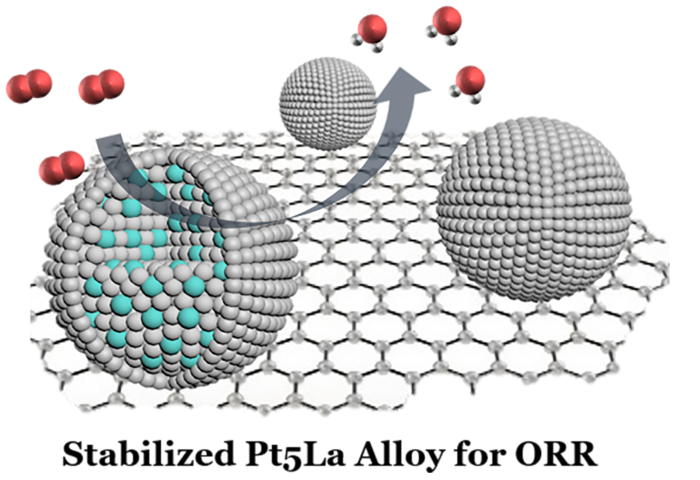Scientists have devised a method for integrating expensive platinum and a cheap rare earth element, lanthanum, as an alloy to function as a catalyst in the following generation of fuel cells that will reduce their cost and enhance their performance. The development needs to make it simpler to decarbonize heavy transport vehicles, which are less cooperative in using batteries to power them.

Platinum-lanthanum nanoparticles acting as electrocatalysts to speed up the chemical reaction in a hydrogen fuel cell to produce electricity and water. Image Credits: Nano Research, Tsinghua University Press
This approach is explained in a paper published on August 4th, 2022, in the journal Nano Research.
Batteries might have succeeded in the fight against hydrogen fuel cells for easily powering cars. However, several other types of transportation find it tough to exchange internal combustion engines for batteries owing to various difficulties such as the volume and weight of batteries needed for the type of services they offer.
This is especially true for heavy transport such as aviation, shipping, and long-haul trucking.
A fuel cell can power vehicles and other machines by transforming the hydrogen chemical energy into electricity, with heat and water being the only other outputs. Until now, the most commonly used fuel cell type in several devices, from satellites to the Space Shuttle, has been the alkaline fuel cell—the invention of which dates back almost 100 years.
The following generation will probably seem somewhat like Polymer Electrolyte Membrane Fuel Cell that also employs hydrogen to generate electricity, but it is much more compact, which makes it particularly suitable for heavy transport vehicles.
Finding better catalysts, which are materials that accelerate electrochemical reactions, is the solution to make those reactions more effective and, thereby, decrease the price of fuel cells, making them more economical with fossil fuels usage.
Unfortunately, platinum is the best of all such “electrocatalysts” that make the main chemical reaction (the oxygen reduction reaction or ORR) a reality. Platinum, a rare metal, is not economical. The unbelievable expensiveness of platinum has been an important hindrance to their adoption, particularly for PEMFCs,
The situation has been made worse by the quick degradation after comparatively fewer cycles of use of this already costly electrocatalyst in the highly corrosive PEMFC environment.
So the hunt is on for an electrocatalyst that is low-cost, more resistant to degradation and thus stable over longer periods of time, while also delivering impressive current density—in other words the amount of electrical current per unit of volume and so enabling us to keep the promise of the compactness of PEMFCs.
Siyuan Zhu, Study Co-Author and Electrochemist, Changchun Institute of Applied Chemistry, Chinese Academy of Sciences
The key choice that has been considered for reducing the cost is “diluting” the quantity of platinum required as an electrocatalyst by enabling it with other economical metals that can help or even improve the catalytic properties of platinum.
So far, the so-called late transition metals have been significant candidates for alloying with platinum. These are the elements one can discover in the center, or d-block, of the Periodic Table. Manganese, iron, and chromium are transition metals in the center of that middle block, and the “late” transition metals, such as zinc and cadmium, can be seen on the right side of it.
Late transition metals are susceptible to dissolution in the extreme, corrosive PEMFC environment. This not only leads to a stable downfall in performance but also the dissolved metal reacts more with byproducts of the ORR, which causes overpowering destruction to the complete system.
Nevertheless, the early transition metals on the left side of the middle block in the Periodic Table like scandium and yttrium are much steadier. Based on theoretical calculations, platinum alloys and these two early transition metals are shown to be the steadiest until now.
One group has been ignored until now among the early transition metals— rare earth elements (REEs). Unlike the name, REEs are quite common in the Earth’s crust and can contribute considerably to the catalysts’ electrochemical activity.
The concern in exploring REEs as probable alloy partners for platinum is not due to the cost issues, but rather due to their poor solubility and conductivity in acidic media. In general, both issues could be surpassed with synthetic methods for creating a platinum-REE alloy; however, for now, there are few reports of any practical synthetic methods.
Therefore, the scientists devised one for producing an alloy between platinum and REE lanthanum.
Two easy steps are involved in the technique. First, the scientists gained readily accessible lanthanum salts and trimesic acid, and then these two precursor materials self-assembled into nano-scale “rods.” Following that, these nanorods were impregnated at 900 °C with platinum. Such a high temperature is essential to ensure a seamless process of alloying the two metals.
Subsequent platinum-lanthanum nanoparticles were stress-tested for their functioning in a fuel cell. The alloy electrocatalyst overcomes scientists' expectations, offering high stability and activity beyond 30,000 fuel-cell cycles.
After the success of lanthanum as an alloy partner for platinum has been proved, the scientists now wish to attempt other rare earth elements to alloy with platinum to check if they can surpass the electrocatalytic performance of lanthanum.
Journal Reference
Zhu, S., et al. (2022) Ultra-stable Pt5La intermetallic compound towards highly efficient oxygen reduction reaction. Nano Research. doi.org/10.1007/s12274-022-4868-3.